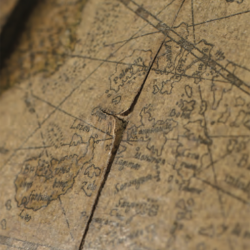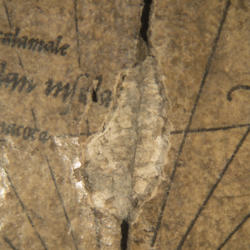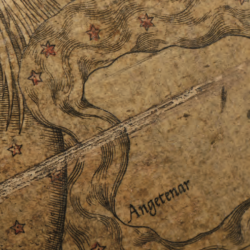Condition of the globes prior to their restoration
Since the terrestrial and celestial globes were manufactured practically the same way using practically identical materials, the observations and condition report summarised here generally apply to both globes. When differences warrant separate remarks, this will be made clear.
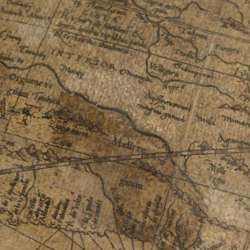
Close-up of terrestrial globe (TG) : abrasion and scratches on the surface of the varnish (sometimes also on the paper, light areas in the upper part of de the image) due to rubbing against the wooden horizon ring. (Ill. 18, SIK|ISEA report)
Overall construction
The sphere of the terrestrial globe has slipped downwards slightly on its metal shaft; leaving it off-centre in relation to the wooden horizon ring. The celestial globe suffers from the same problem but its position was corrected in an earlier restoration by adding a small metal ring to hold it higher. Even so the spheres are not centred, and because of this they rest on the wooden ring and rub against it.
The tip of the terrestrial globe’s metal shaft is broken.
The meridians are oxidised and stained. Moreover, in an earlier restoration they were varnished (mainly the edge) very unevenly, causing runs.
Gores
The paper strips and calottes that cover the surface of the spheres are peeling slightly at the joints, probably owing to strong tension within the layers of varnish. The detached paper has been weakened and bits are missing in these areas, exposing the preparatory chalk layer underneath. The surface also shows a number of scratches, most of which have been caused by sliding the runner along the latitudes.
- Close-up of TG: peeling along the gores’ edges. Tears in the areas that have come unstuck. (Ill. 15, SIK|ISEA report)
- Close-up of TG: peeling along the gores’ edges and missing bits of paper. (Ill. 16, SIK|ISEA report)
- Close-up of TG: natural scratches due to use of the runner. (Ill. 17, SIK|ISEA report)
The colours have deteriorated; they have faded and the greens have often turned yellow-brownish. This wear could be due to the globes’ use over time and to their natural degeneration, but it may also have been exacerbated by cleaning the varnish in an earlier restoration.
Surfaces
The outer varnish (not original) is in rather good condition but oxidised, and has a marked yellow appearance. Moreover, in some areas the surface is worn and the varnish has all but disappeared. In these spots the surface of the paper, no longer protected, is badly soiled. The varnish also has also lost its gloss in places.
The remains of older varnish are very heavily oxidised, forming dark stains where the paper is pitted.
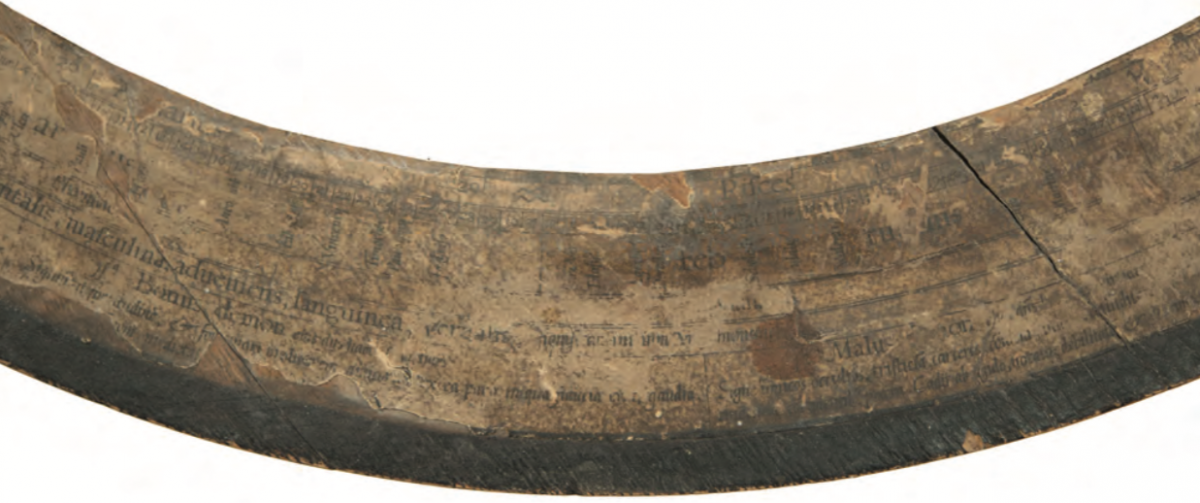
Close-up of the celestial globe (CG) prior to restoration: we can see cracks in the horizon ring, open joints, missing bits of paper, oxidation of the varnish, abrasions on the surface of the paper and stains. (Ill. 21, SIK|ISEA report)
Paper layer
The paper strips glued to the horizon rings are badly damaged, far more than the gores covering the spheres. This is due to their horizontal disposition, which causes an accumulation of grime. Moreover, these areas have probably been touched considerably during the globes’ use.
In particular, the paper has peeled and crinkled along the edges. There are tears and numerous pieces missing, as large as 6 cm2. The printed surfaces are moreover so worn and chafed in places that the ink has disappeared and only a very thin layer of paper remains.
Water damage has displaced the dirt in some places and left moisture stains.
Surfaces
The varnish on the rings is heavily oxidised and has turned brown (much more than on the spheres). The surface of the rings is moreover very dirty, particularly on the unvarnished band where the accumulation of grime in the paper fibres has often made the printing illegible. The layer is so thick that it has come off in places, taking the surface of the paper with it.
There are drops of white paint on the surfaces, especially that of the celestial globe.
Wood
The edges of the wooden rings are worn. This wear runs deeper in some places, and there are also nicks and cracks. Some of the cracks running cross-wise have been closed using small nails (not original). For the moment they do not pose any risk to the rings’ stability.
The dove-tailing is no longer even and can often be seen through the paper layer.
The rings, like the stands, have been taken off and put back on in the past. A dove-tail on the celestial globe was replaced by a piece of metal (not original). The moulded rim was painted over with opaque black paint that sometimes covers over earlier wear of the wood.
The black moulded rim is spotted with traces of white and turquoise paint.
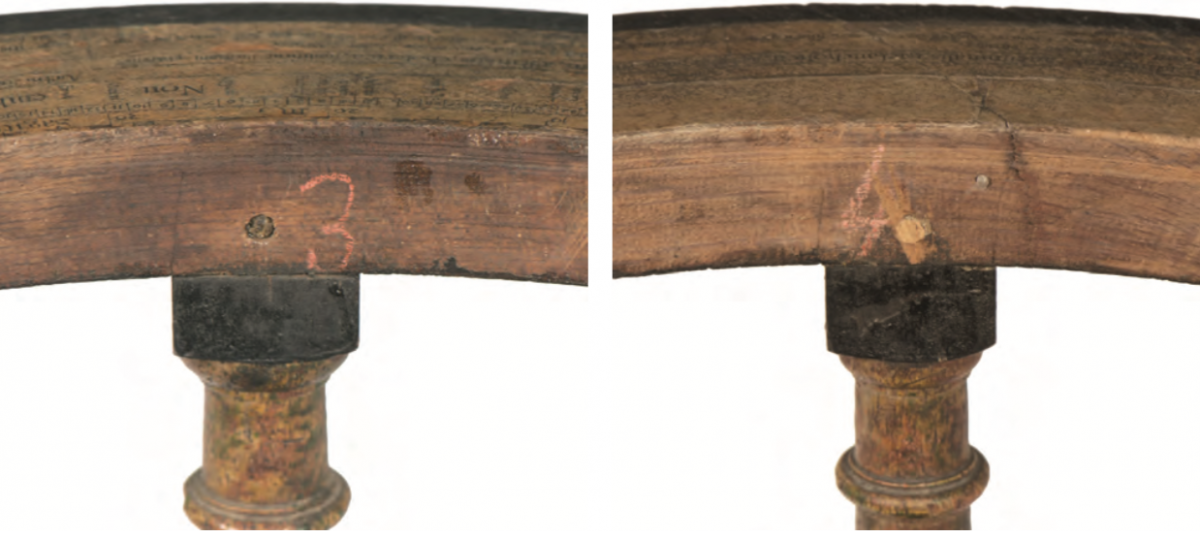
CG, inside face of the stand: the positions of the feet are marked with pink chalk. The stand was taken apart and glued back together in an earlier restoration. On the left we can see that the wooden peg (or dowel) was replaced with a new one. (Ill. 23-24, SIK|ISEA report)
In an earlier restoration, the stands were taken apart and then reassembled using glue, dowels, nails, screws and pieces of metal. While the stands were disassembled, the positions of the balusters were marked and numbered from 1 to 4 with pink chalk.
The dowels holding the balusters to the horizon ring were replaced and the joints re-glued. This restoration showed little regard for the original assemblies and the pieces were glued clumsily. Beads of glue spill over from the joints and the pieces are not always flush (e.g. the planks of the circular base are slightly misaligned). The black parts of the stand were likewise coarsely painted over. It is difficult to know what colour these parts were originally, but that coat of paint was probably much thinner and applied more thoroughly than the later one.
The stands also show natural wear, particularly along the edges and in the corners. Some of this wear was painted over in black.
The paper layer with the red-green markings has worn very thin and in some places right through to the wood.
The needles of the compasses have disappeared along with the glass that probably covered them.
On the circular base of the celestial globe, there are remains of glue from an earlier label.
Find out more
- Les globes de Mercator de l’Université de Lausanne. Observations matérielles. Constat d’état. Rapport de conservation-restauration : The Mercator globes of the University of Lausanne. Material observations. Condition report. Report on conservation-restoration, Workshop and laboratory of the Swiss Institute for Art Research SIK|ISEA, Ref. No. 141110 0002: 01/02, October 2015, Margaux Genton, Zurich.
